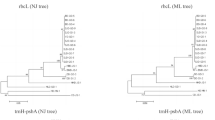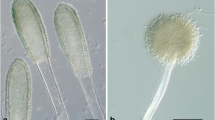Abstract
Epidemiological data showed increasing incidence rates of gastrointestinal (GI) mushroom syndrome in Thailand. This study therefore, aimed to identify suspected GI toxin-containing mushrooms using DNA sequence analyses of the internal transcribed spacer (ITS) region and the large subunit (LSU) of nuclear ribosomal DNA. GI toxins were also identified using liquid chromatography quadrupole time-of-flight mass spectrometry (LC-QTOF-MS). 39 patients presented with poisoning symptoms, including nausea, vomiting, fatigue, abdominal pain, circulatory disturbances and diarrhea after ingesting wild mushrooms. The latent periods varied from 30 min to 4 h, but mostly between 1 and 2 h. Results of the ITS sequence-based identification revealed high similarities for the obtained clinical mushroom samples with the genus Cantharocybe H.E. Bigelow & A.H. SM. Maximum likelihood and Bayesian summary trees of combined ITS and LSU data confirmed that these toxic mushroom samples ingested by the patients belonged to Cantharocybe virosa (Manim. & K.B. Vrinda) T.K.A. Kumar. Detection of GI toxins using LC-QTOF-MS method revealed the presence of coprine in C. virosa. This study described the first outbreak of C. virosa poisoning in Thailand which resulted in severe cases of gastrointestinal irritation. To prevent such poisoning cases it is essential to educate the public not to gather any unidentified or unfamiliar wild mushrooms.





Similar content being viewed by others
References
Chandrasrikul A, Suwanarit P, Sangwanit U, Lumyong S, Payapanon A, Sanoamuang N, Pukahuta C, Petcharat V, Sardsud U, Duengkae K, Klinhom U, Thongkantha S, Thongklam S (2011) Checklist of mushrooms (Basidiomycetes) in Thailand. Office of Natural Resources and Environmental Policy and Planning, Bangkok
Chaiear K, Limpaiboon R, Meechai C, Poovorawan Y (1999) Fatal mushroom poisoning caused by Amanita virosa in Thailand. Southeast Asian J Trop Med Public Health 30:157–160
Parnmen S, Sikaphan S, Leudang S, Boonpratuang T, Rangsiruji A, Naksuwankul K (2016) Molecular identification of poisonous mushrooms using nuclear ITS region and peptide toxins: a retrospective study on fatal cases in Thailand. J Toxicol Sci 41:65–76
Leudang S, Sikaphan S, Parnmen S, Nantachaiphong N, Polputpisatkul D, Ramchiun S, Teeyapant P (2017) DNA-based identification of gastrointestinal irritant mushrooms in the genus Chlorophyllum: a food poisoning case in Thailand. J Heal Res 31:41–49
Ramchiun S, Sikaphan S, Leudang S, Polputpisatkul D, Nantachaiphong N, Khaentaw T, Nooron N, Uttawichai C, Parnmen S (2018) Molecular characterization and liquid chromatography-mass spectrometric multiple reaction monitoring-based detection in case of suspected phalloides syndrome poisoning. J Assoc Med Sci 52:47–54
Li GJ, Hyde KD, Zhao RL, Hongsanan S, Abdel-Aziz FA, Abdel-Wahab MA, Alvarado P, Alves-Silva G, Ammirati JF, Ariyawansa HA, Baghela A, Bahkali AH et al (2016) Fungal diversity notes 253–366: taxonomic and phylogenetic contributions to fungal taxa. Fungal Divers 78:1–237
Kumar TKA, Manimohan P (2013) Molecular phylogeny reveals Megacollybia virosa is a Cantharocybe. Mycotaxon 124:231–238
Lodge DJ, Padamsee M, Matheny PB, Aime MC, Cantrell SA, Boertmann D, Kovalenko A, Vizzini A, Dentinger BTM, Kirk PM, Ainsworth AM, Moncalvo J-M, Vilgalys R, Larsson E, Lücking R, Griffith GW, Smith ME, Norvell LL, Desjardin DE, Redhead SA, Ovrebo CL, Lickey EB, Ercole E, Hughes KW, Courtecuisse R, Young A, Binder M, Minnis AM, Lindner DL, Ortiz-Santana B, Haight J, Læssøe T, Baroni TJ, Geml J, Hattori T (2014) Molecular phylogeny, morphology, pigment chemistry and ecology in Hygrophoraceae (Agaricales). Fungal Divers 64:1–99
Hosen MI, Li T-H, Lodge DJ, Rockefeller A (2016) The first ITS phylogeny of the genus Cantharocybe (Agaricales, Hygrophoraceae) with a new record of C. virosa from Bangladesh. MycoKeys 14:37–50
White J, Weinstein SA, De Haro L, Bédry R, Schaper A, Rumack BH, Zilker T (2019) Mushroom poisoning: a proposed new clinical classification. Toxicon 157:53–65
Duffy TJ (2008) Toxic fungi of Western North America, Group. MykoWeb
Bresinsky A, Besl H (1990) A colour atlas of poisonous fungi: a handbook for pharmacists, doctors, and biologists. Wolfe Publishing Ltd, London
Schoch CL, Seifert KA, Huhndorf S, Robert V, Spouge JL, Levesque CA, Chen W (2012) Nuclear ribosomal internal transcribed spacer (ITS) region as a universal DNA barcode marker for Fungi. Proc Natl Acad Sci USA 109:6241–6246
Raja HA, Miller AN, Pearce CJ, Oberlies NH (2017) Fungal identification using molecular tools: a primer for the Natural Products Research Community. J Nat Prod 80:756–770
Gardes M, Bruns TD (1993) ITS primers with enhanced specificity for basidiomycetes—application to the identification of mycorrhizae and rusts. Mol Ecol 2:113–118
White TJ, Bruns TD, Lee SB, Taylor JW (1990) Amplification and direct sequencing of fungal ribosomal RNA genes for phylogenetics. In: Innis MA, Gelfand DH, Sninsky JJ, White T (eds) PCR protocols: a guide to methods and applications. Academic Press, New York, pp 315–322
Vilgalys R, Hester M (1990) Rapid genetic identification and mapping of enzymatically amplified ribosomal DNA from several Cryptococcus species. J Bacteriol 172:4238–4246
Altschul SF, Madden TL, Schäffer AA, Zhang J, Zhang Z, Miller W, Lipman DJ (1997) Gapped BLAST and PSI-BLAST: a new generation of protein database search programs. Nucleic Acids Res 25:3389–3402
Castresana J (2000) Selection of conserved blocks from multiple alignments for their use in phylogenetic analysis. Mol Biol Evol 17:540–552
Talavera G, Castresana J (2007) Improvement of phylogenies after removing divergent and ambiguously aligned blocks from protein sequence alignments. Syst Biol 56:564–577
Miller MA, Pfeiffer W, Schwartz T (2010) Creating the CIPRES science gateway for inference of large phylogenetic trees. In: Proceeding of the Gateway Computing Environments Workshop (GCE), New Orleans, pp 1–8
Stamatakis A (2014) RAxML version 8: a tool for phylogenetic analysis and post-analysis of large phylogenies. Bioinformatics 30:1312–1313
Ronquist F, Teslenko M, van der Mark P, Ayres DL, Darling A, Höhna S, Larget B, Liu L, Suchard MA, Huelsenbeck JP (2012) MrBayes 3.2: efficient Bayesian phylogenetic inference and model choice across a large model space. Syst Biol 61:539–542
Boonpratuang T, Choeyklin R, Promkium-on P, Teeyapan P (2012) The identification of poisonous mushrooms in Thailand during 2008–2012. Thai Mushroom, pp 6–13
Ovrebo CL, Lodge DJ, Aime MC (2011) A new Cantharocybe from Belize with notes on the type of Cantharocybe gruberi. Mycologia 103:1102–1109
Manimohan P, Kumar TKA, Vrinda KB, Pradeep CK (2010) Megacollybia virosa, a new species with toxic basidiomata from India. Mycotaxon 111:363–368
Cochran KW, Cochran MW (1978) Clitocybe clavipes: antabuse-like reaction to alcohol. Mycologia 70:1124–1126
Graeme KA (2014) Mycetism: a review of the recent literature. J Med Toxicol 10:173–189
Acknowledgements
This work was financially supported by the Department of Medical Sciences, Ministry of Public Health for the project “Molecular genetic databases of poisonous mushrooms for clinical toxicology” (Project code: 6662). The authors wish to thank Mr. Sathaporn Ramchiun and Bruker application specialist (Thailand) for their useful suggestions on toxin identification as well as the Bureau of Drug and Narcotic for allowing us to use the instrument and facilities in the laboratory.
Author information
Authors and Affiliations
Corresponding author
Ethics declarations
Conflict of interest
The authors declare that there is no conflict of interest regarding the publication of this paper.
Rights and permissions
About this article
Cite this article
Parnmen, S., Nooron, N., Leudang, S. et al. Phylogenetic evidence revealed Cantharocybe virosa (Agaricales, Hygrophoraceae) as a new clinical record for gastrointestinal mushroom poisoning in Thailand. Toxicol Res. 36, 239–248 (2020). https://doi.org/10.1007/s43188-019-00024-2
Received:
Revised:
Accepted:
Published:
Issue Date:
DOI: https://doi.org/10.1007/s43188-019-00024-2




